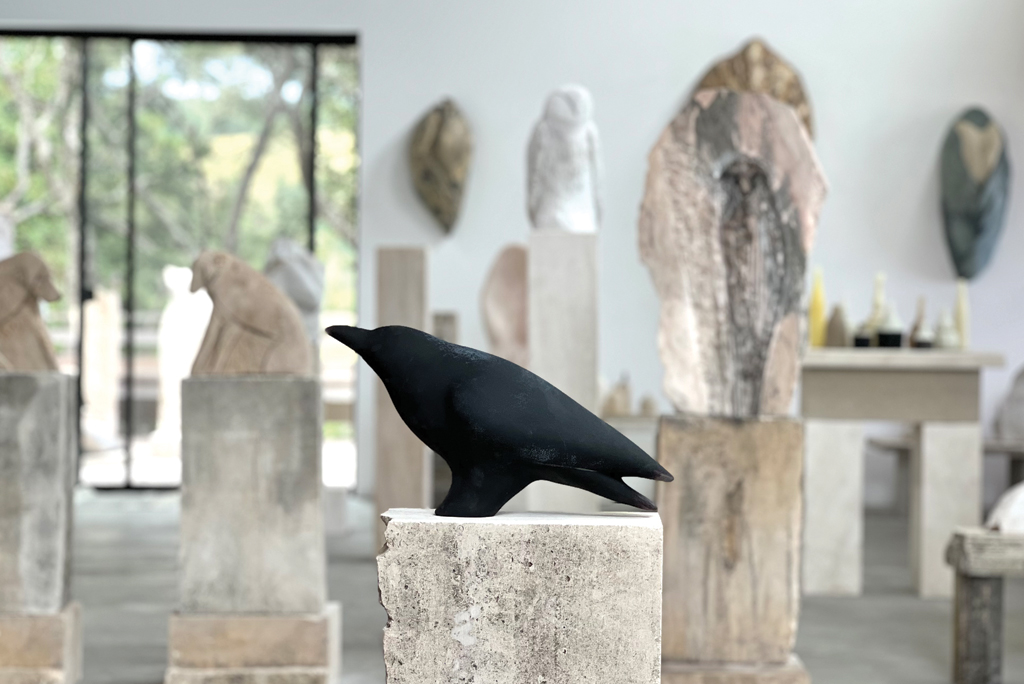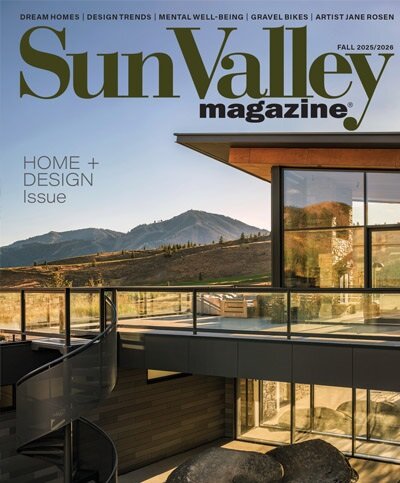Arrested movement captured in stone. The flash of form. Gestural lines suggesting flight and the expanse of flowing motion conveyed through the simple sweep of a wing. These are all elements of artist Jane Rosen’s body of work—compositional stories in glass, stone and drawn form inspired by the birds, horses, dogs, deer, hawks and ravens she encountered in nature.
Sadly, Rosen passed away earlier this year, in Northern California, leaving behind a community of students, collaborators, and collectors who honor her work for its quiet presence and clarity, and understand Rosen’s unique ability to capture the stories of the natural world with an immediacy and reverence that claim our focus, our attention and a sublime and sacred devotion to the nature of seeing.
The body of Rosen’s work is filled with an homage to nature, imbued with both the wonder and simplicity of curves and lines, and an almost otherworldly or holy interpretation of the language of science. Her marble and limestone sculpture, blown glass pieces, and drawings and prints are reductive in nature, demonstrating restraint while also capturing the abundance of nature and the flash of form and musculature, the very essence of an animal’s spirit and lifeform.

“Mama Raven” by Jane Rosen, handblown pigmented glass on limestone, 22 inches x 18 inches.
Most of her forms are pictured at rest but carry a stillness that contains all possible movement: birds perched or standing, watching and vigilant, but infused with an alertness and readiness to spring into immediate action. Each piece contains this charged duality: both detachment and an immediacy that demands our attention. Lines drop like the beat of a wing, misty washes become atmosphere, and glass arrests the graceful attention of a perched goshawk in a medium that captures light and reflects the expanse of sky.
“I suspect I switch between levels of abstraction and figuration—by starting with the study of a form—a pinecone, for example—until I understand its formation and know the thing well,” Rosen stated in a journal excerpt from her book “Dual Nature.” “These drawings are often more realistic until I can understand them well enough to reduce them to their essence. Pinecone petals—they are called cone scales—look like bird beaks.”
Born in New York City in 1950, Rosen attended New York University, continuing her studies at the Art Students League where she trained in the classical drawing lineage of Robert Beverly Hale and developed a fascination with Leonardo da Vinci and other great Renaissance masters. Rosen spent her formative years living and working in the SoHo of 1970s New York City. Her commitment to experimentation and melding of presumably opposing concepts began during this time, and her work often combined Renaissance technique and ways of seeing with Eastern philosophy, Egyptian forms, and elements of Minimalism.
Rosen’s work carries an unusual mix of precision and wonder, elements that the artist carried forward into all areas of her life. “Art is a way to ask questions about what one wishes to understand,” said Rosen, who also taught art for nearly five decades at a number of institutions, including the School of Visual Arts in New York, U.C. Berkeley, Stanford, and U.C. Davis. As a teacher, she emphasized the importance of perception over performance and encouraged her students to experience drawing and sculpture as practices in awareness rather than displays of skills.
After two decades in the New York art world, Rosen made a single, and fateful, visit to a rural property in San Gregorio in Northern California, where a profound experience with the natural world—more specifically, with a red-tailed hawk—prompted her to leave Manhattan to live on a windswept ranch high above the Pacific Ocean. Here, the natural world of owls, foxes, ravens, horses, falcons and hawks became her daily companions and, eventually, central subjects.
 In the prose and journal excerpts of her self-published book, “Dual Nature,” Rosen provides a glimpse into her lifelong “love of where nature, science and art meet.” She speaks of animals as teachers, their “natural intelligence” a counterpoint to human chatter. For Rosen, watching a kestrel hunt or an owl listen was a lesson in attention and form. Her desire was to heighten perception and trim away noise until only the essential remained.
In the prose and journal excerpts of her self-published book, “Dual Nature,” Rosen provides a glimpse into her lifelong “love of where nature, science and art meet.” She speaks of animals as teachers, their “natural intelligence” a counterpoint to human chatter. For Rosen, watching a kestrel hunt or an owl listen was a lesson in attention and form. Her desire was to heighten perception and trim away noise until only the essential remained.
Sometimes to capture the essence of a form, Rosen would only watch the shadow of it—trying to truly SEE without looking directly, but feeling where the form existed and how it moved. She often described teaching and drawing as “seeing through touch,” a method that asked the hand and eye to move as one and reflected her belief that seeing had nothing to do with the eyes. In her mind, it was a way of rejecting symbols of the traditional “seen” form and the expected shape of things and relying instead on gesture to capture the essence of a being.
In this way her work conjures the mystical, capturing the spirit of a thing in simple economies of line and shape. Her blown glass birds and animals appear to be waiting and watching, telling stories of the natural world through forms that carry a monkish-like stillness and mystical detachment.
Her blown glass pieces include bits of stone dust or fragments of line drawings, becoming compositions that both reflect and absorb light simultaneously, like the moving of light across the still form of a perched bird resting in a tree.
In a journal excerpt from “Dual Nature,” Rosen recounts her collaboration with master glassblower Ross Richmond, when the two had spent “…hours and days doing drawings with chips of glass that we bake and then roll onto hot glass for the glass birds to contain actual drawings fused into their translucent surfaces. It is a time rich with new explorations of how nature can be the story to be told through the history of the language of art. I have always felt that if people saw what I see in nature, in the animals around me, and in the trees, that they would not destroy them. It is my hope that this story can be heard.”

